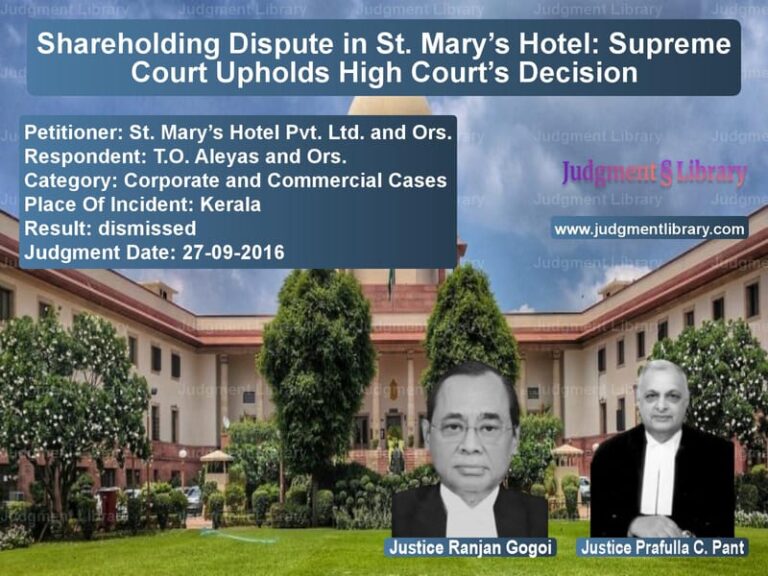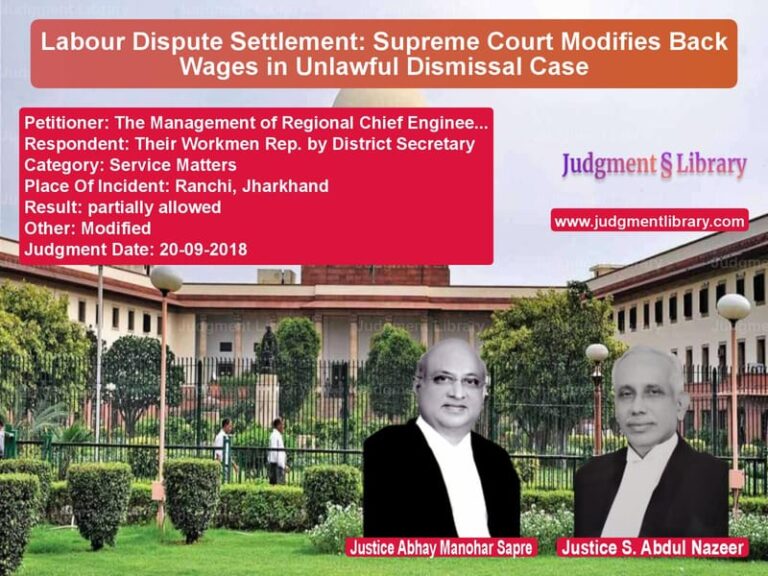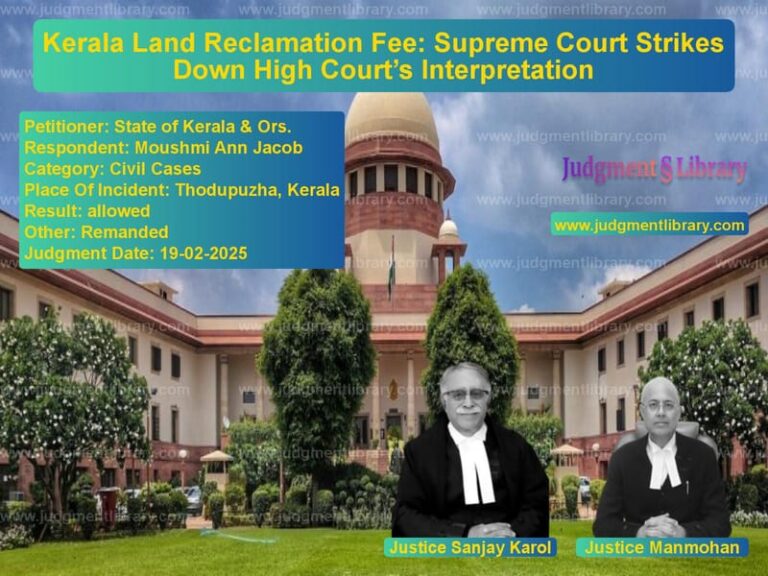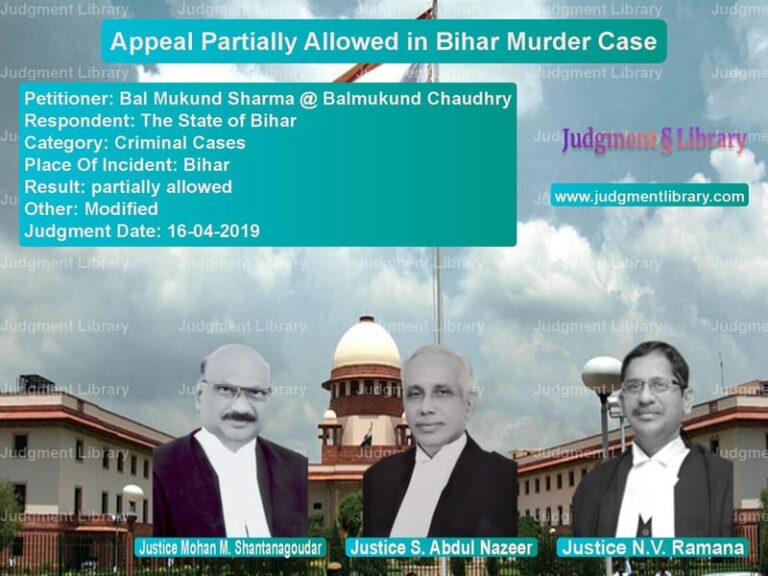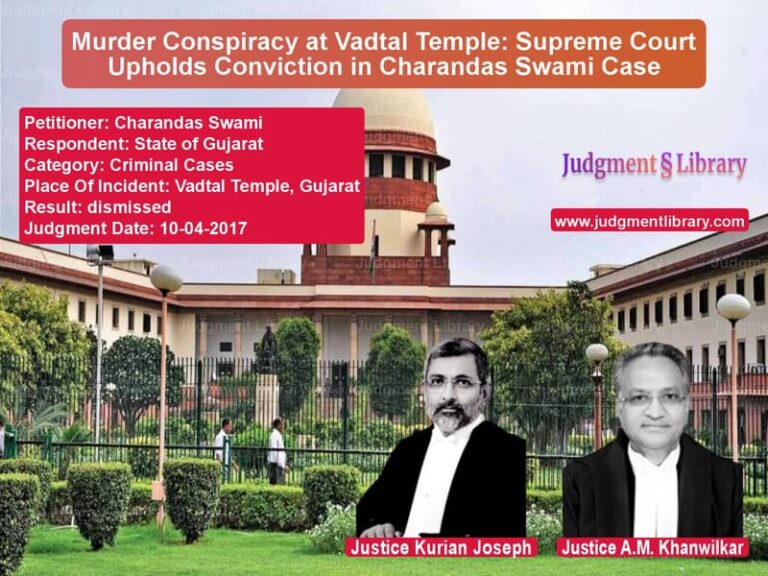SARFAESI Act and the Powers of District Magistrates in Possession of Secured Assets: A Case Analysis
The case concerns a dispute involving the appellant, Balkrishna Rama Tarle (dead thr. LRs), and the respondent, Phoenix ARC Private Limited, under the provisions of the Securitisation and Reconstruction of Financial Assets and Enforcement of Security Interest (SARFAESI) Act, 2002. The primary issue at hand is whether the District Magistrate, while exercising powers under Section 14 of the SARFAESI Act, can intervene and prevent the secured creditor from taking possession of mortgaged assets if the borrower or third parties, such as tenants, are in possession of the secured property. The appellant claims to be a tenant of part of the secured assets and argues that his rights must be protected before any possession can be granted to the secured creditor. The Supreme Court, after hearing both sides, dismissed the appeal, agreeing with the High Court’s decision to direct the District Magistrate to proceed under the SARFAESI Act. This blog explores the arguments, the legal reasoning, and the court’s decision in detail.
Background of the Case
The dispute originates from a loan sanctioned by Religare Finvest Ltd. in favor of certain borrowers, which was later assigned to Phoenix ARC Private Limited. Due to non-payment, the loan was classified as a Non-Performing Asset (NPA), and Phoenix ARC initiated proceedings under the SARFAESI Act. In 2018, Phoenix ARC took possession of the secured assets and subsequently filed an application under Section 14 of the SARFAESI Act for assistance from the District Magistrate in taking physical possession of the mortgaged assets. The appellant, who claims to be a tenant in part of the mortgaged property, contested this application, arguing that his tenancy rights must be respected before any action can be taken by the secured creditor. The District Magistrate initially deferred the decision, stating that the secured creditor must first terminate the appellant’s tenancy rights by following due process of law before proceeding with possession. The High Court, however, set aside this order, and the appellant filed an appeal in the Supreme Court.
Petitioner’s Arguments
The appellant, Balkrishna Rama Tarle, presented several points in support of his case:
- Existence of Tenancy Rights: The appellant argued that he had a valid and continuing tenancy agreement over part of the secured assets. He emphasized that his rights as a tenant must be protected and that the secured creditor could not take possession of the property without first terminating his tenancy rights by following due legal procedures.
- Precedent of Previous Decisions: The appellant cited previous Supreme Court decisions, particularly Harshad Govardhan Sondagar v. International Assets Reconstruction Company Limited and Vishal N. Kalsaria v. Bank of India, which held that the rights of tenants must be respected before possession can be granted under the SARFAESI Act. He contended that the legal process for eviction must be initiated before any action to take possession of the property can occur.
- Absence of Legal Proceedings for Eviction: The appellant pointed out that, while the secured creditor had initiated proceedings under the SARFAESI Act, they had not filed for eviction against him. He argued that the secured creditor could not bypass the legal process for eviction and take possession without first addressing his tenancy rights.
Respondent’s Arguments
The respondent, Phoenix ARC Private Limited, countered the appellant’s claims with the following points:
- Possession Under SARFAESI Act: The respondent argued that under the provisions of the SARFAESI Act, the secured creditor has the right to take possession of the mortgaged property if the borrower defaults on repayment. They emphasized that the SARFAESI Act is designed to allow financial institutions to recover dues without the intervention of courts, and that the District Magistrate is empowered to assist in taking possession of the secured assets under Section 14 of the Act.
- Role of the District Magistrate: The respondent highlighted that the District Magistrate’s role under Section 14 of the SARFAESI Act is primarily ministerial. They argued that once the required formalities were met, the District Magistrate should assist in taking possession of the secured assets without adjudicating on the rights of tenants or borrowers.
- Failure to Initiate Legal Proceedings: The respondent argued that neither the borrowers nor the appellant had initiated any proceedings before the Debt Recovery Tribunal (DRT) under Section 17 of the SARFAESI Act to challenge the steps taken by the secured creditor. They contended that the District Magistrate’s action was appropriate and in line with the law.
The Court’s Reasoning
The Supreme Court, after considering the arguments from both sides, arrived at the following conclusions:
- Scope of Section 14 of SARFAESI Act: The Court examined the scope of Section 14 of the SARFAESI Act, which allows the secured creditor to request the District Magistrate for assistance in taking possession of the secured assets. The Court emphasized that the District Magistrate’s role is ministerial and that their responsibility is to assist the secured creditor once all formalities are complied with.
- Tenancy Rights and the SARFAESI Act: The Court acknowledged that tenants have rights under the law, but it emphasized that the SARFAESI Act does not provide for the adjudication of tenancy disputes. The Court noted that while the appellant claimed to be a tenant, the proper forum for challenging the possession would be the Debt Recovery Tribunal (DRT), not the District Magistrate under Section 14.
- Ministerial Role of the District Magistrate: The Court agreed with the respondent’s argument that the District Magistrate’s function under Section 14 is ministerial. The Court pointed out that once the necessary formalities are fulfilled, the District Magistrate must assist the secured creditor in taking possession of the property. The Court held that the District Magistrate’s role does not extend to adjudicating the rights of tenants or other parties claiming possession of the secured property.
- Eviction Process: The Court clarified that while the SARFAESI Act allows the secured creditor to take possession of the secured property, the eviction process for tenants must follow the legal procedures for eviction. The Court noted that the secured creditor had not yet initiated legal proceedings for eviction and suggested that such proceedings be initiated in due course.
The Court’s Decision
The Supreme Court ultimately dismissed the Special Leave Petition filed by the appellant, agreeing with the High Court’s decision. The Court made the following orders:
- Dismissal of the Appeal: The Court upheld the High Court’s decision to set aside the order passed by the District Magistrate and directed the District Magistrate to proceed with the application under Section 14 of the SARFAESI Act in accordance with the provisions of the Act.
- Further Legal Proceedings for Eviction: The Court noted that the appellant’s tenancy rights could be contested through legal proceedings before the appropriate forum, i.e., the Debt Recovery Tribunal (DRT), and not during the possession proceedings under the SARFAESI Act.
Conclusion
This case underscores the limited role of the District Magistrate under Section 14 of the SARFAESI Act. The Court emphasized that the SARFAESI Act is designed to allow secured creditors to take possession of mortgaged properties in case of default without the need for judicial intervention. However, the rights of tenants and other third parties claiming possession must be addressed through the appropriate legal processes, such as the Debt Recovery Tribunal. The Court’s decision highlights the need to follow the legal procedures for eviction and the importance of adhering to the provisions of the SARFAESI Act for asset recovery.
Read also: https://judgmentlibrary.com/unregistered-agreement-to-sell-supreme-court-rules-on-property-dispute/
Petitioner Name: Balkrishna Rama Tarle Dead Thr LRs.Respondent Name: Phoenix ARC Private Limited.Judgment By: Justice M.R. Shah, Justice Krishna Murari.Place Of Incident: Maharashtra.Judgment Date: 26-09-2022.
Don’t miss out on the full details! Download the complete judgment in PDF format below and gain valuable insights instantly!
Download Judgment: balkrishna-rama-tarl-vs-phoenix-arc-private-supreme-court-of-india-judgment-dated-26-09-2022.pdf
Directly Download Judgment: Directly download this Judgment
See all petitions in Contract Disputes
See all petitions in Property Disputes
See all petitions in Damages and Compensation
See all petitions in Debt Recovery
See all petitions in Judgment by Mukeshkumar Rasikbhai Shah
See all petitions in Judgment by Krishna Murari
See all petitions in dismissed
See all petitions in supreme court of India judgments September 2022
See all petitions in 2022 judgments
See all posts in Civil Cases Category
See all allowed petitions in Civil Cases Category
See all Dismissed petitions in Civil Cases Category
See all partially allowed petitions in Civil Cases Category


